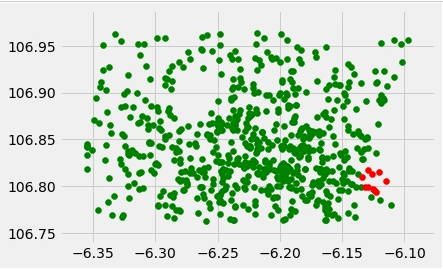有刚入门的小白不知道numpy中如何使用mask,今天小编就来讲讲使用mask会遇到的一些问题。
numpy中矩阵选取子集或者以条件选取子集,用mask是一种很好的方法。
简单来说就是用bool类型的indice矩阵去选择。
mask = np.ones(X.shape[0], dtype=bool) X[mask].shape mask.shape mask[indices[0]] = False mask.shape X[mask].shape X[~mask].shape (678, 2) (678,) (678,) (675, 2) (3, 2)
</pre> 例如我们这里用来选取全部点中KNN选取的点以及所有剩余的点。 from sklearn.neighbors import NearestNeighbors nbrs = NearestNeighbors(10).fit(X) _,indices = nbrs.kneighbors(X) mask = np.ones(X.shape[0], dtype=bool) mask[indices[0]] = False plt.scatter(X[mask][:,0],X[mask][:,1],c=’g’) plt.scatter(X[~mask][:,0],X[~mask][:,1],c=’r’) <pre class="brush:js;toolbar:false">

带条件选择替换,比如我们需要将a矩阵内某条件的行置换为888剩余置换为999,可以直接用mask或者再用where一步搞定:
mask = np.ones(a.shape,dtype=bool) #np.ones_like(a,dtype=bool) mask[indices] = False a[~mask] = 999 a[mask] = 888 ############# np.where(mask, 888, 999)
是不是很容易呢,小伙伴们学会了没有。
神龙|纯净稳定代理IP免费测试>>>>>>>>天启|企业级代理IP免费测试>>>>>>>>IPIPGO|全球住宅代理IP免费测试





